parking sensors TOYOTA PROACE 2020 Owners Manual (in English)
[x] Cancel search | Manufacturer: TOYOTA, Model Year: 2020, Model line: PROACE, Model: TOYOTA PROACE 2020Pages: 430, PDF Size: 48.01 MB
Page 3 of 430
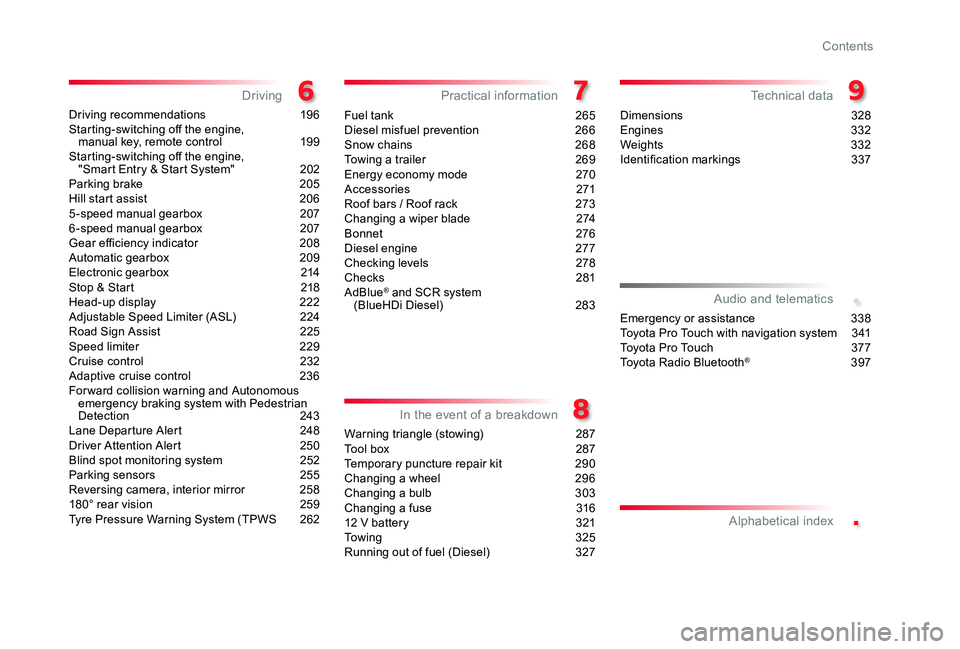
.
.
Driving recommendations 196Starting-switching off the engine, manual key, remote control 199Starting-switching off the engine, "Smart Entry & Start System" 202Parking brake 205Hill start assist 2065-speed manual gearbox 2076-speed manual gearbox 207Gear efficiency indicator 208Automatic gearbox 209Electronic gearbox 214Stop & Start 218Head-up display 222Adjustable Speed Limiter (ASL) 224Road Sign Assist 225Speed limiter 229Cruise control 232Adaptive cruise control 236Forward collision warning and Autonomous emergency braking system with Pedestrian Detection 243Lane Departure Alert 248Driver Attention Alert 250Blind spot monitoring system 252Parking sensors 255Reversing camera, interior mirror 258180° rear vision 259Tyre Pressure Warning System (TPWS 262
Fuel tank 265Diesel misfuel prevention 266Snow chains 268Towing a trailer 269Energy economy mode 270Accessories 271Roof bars / Roof rack 273Changing a wiper blade 274Bonnet 276Diesel engine 277Checking levels 278Checks 281AdBlue® and SCR system (BlueHDi Diesel) 283
Warning triangle (stowing) 287Tool box 287Temporary puncture repair kit 290Changing a wheel 296Changing a bulb 303Changing a fuse 31612 V battery 321Towing 325Running out of fuel (Diesel) 327
Dimensions 328Engines 332Weights 332Identification markings 337
DrivingPractical information
In the event of a breakdown
Technical data
Emergency or assistance 338Toyota Pro Touch with navigation system 3 41To y o t a P r o To u c h 377Toyota Radio Bluetooth® 397
Audio and telematics
Alphabetical index
Contents
Page 4 of 430
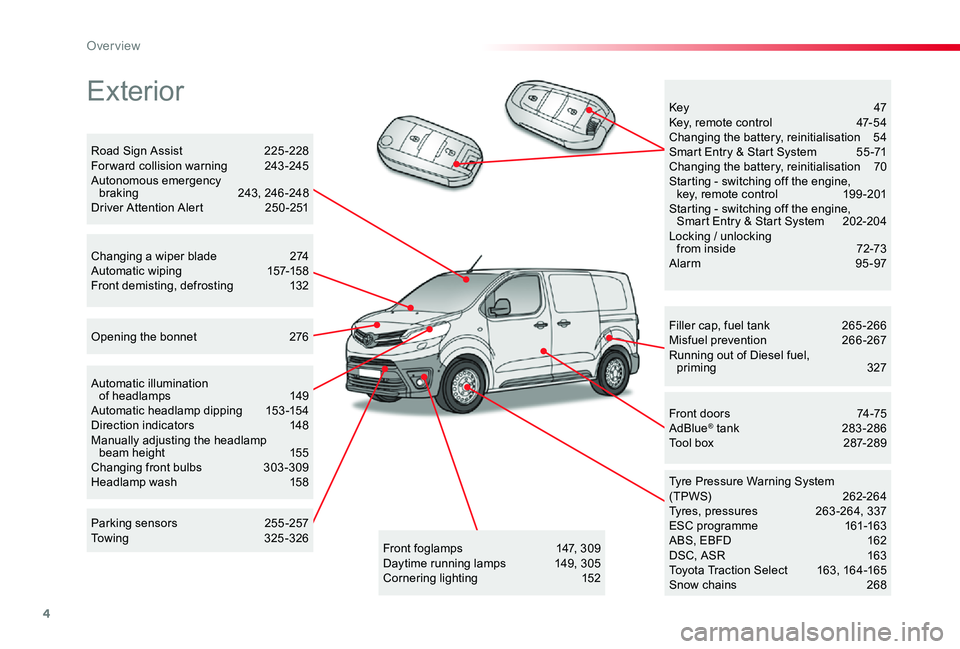
4
Exterior
Filler cap, fuel tank 265 -266Misfuel prevention 266-267Running out of Diesel fuel, priming 327
Tyre Pressure Warning System(TPWS) 262-264Tyres, pressures 263 -264, 337ESC programme 161-163ABS, EBFD 162DSC, ASR 163Toyota Traction Select 163, 164-165Snow chains 268
Front doors 74-75AdBlue® tank 283-286Tool box 287-289
Automatic illumination of headlamps 149Automatic headlamp dipping 153-154Direction indicators 148Manually adjusting the headlamp beam height 155Changing front bulbs 303-309Headlamp wash 158
Opening the bonnet 276
Key 47Key, remote control 47-54Changing the battery, reinitialisation 54Smart Entry & Start System 55 -71Changing the battery, reinitialisation 70Starting - switching off the engine, key, remote control 199 -201Starting - switching off the engine, Smart Entry & Start System 202-204Locking / unlocking from inside 72-73Alarm 95-97
Road Sign Assist 225 -228Forward collision warning 243-245Autonomous emergency braking 243, 246 -248Driver Attention Alert 250-251
Changing a wiper blade 274Automatic wiping 157-158Front demisting, defrosting 132
Front foglamps 147, 309Daytime running lamps 149, 305Cornering lighting 152
Parking sensors 255-257Towing 325-326
Over view
Page 5 of 430
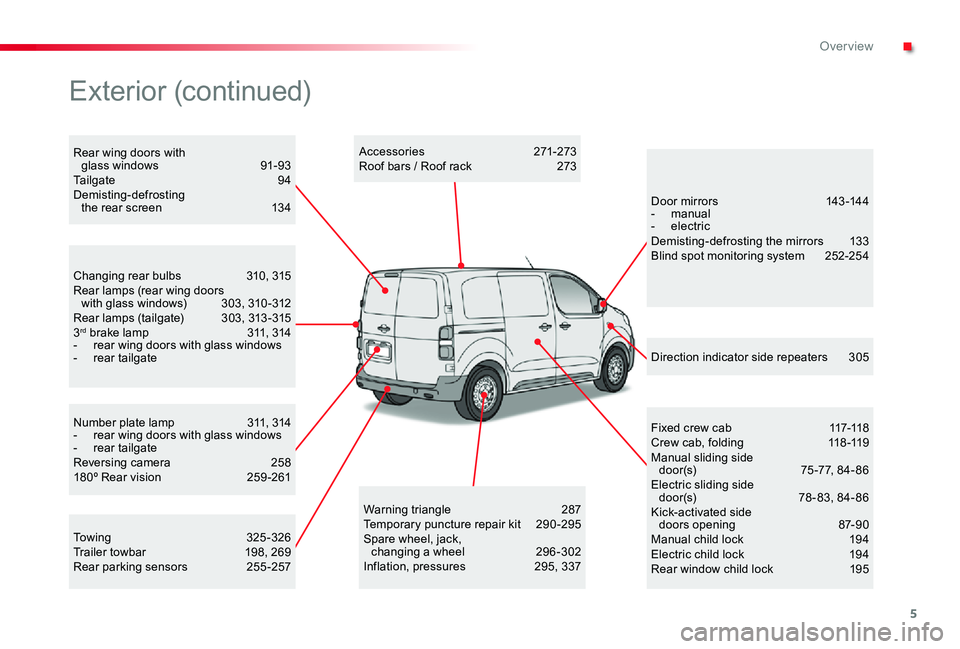
5
Number plate lamp 311, 314- rear wing doors with glass windows- rear tailgateReversing camera 258180º Rear vision 259 -261
Changing rear bulbs 310, 315Rear lamps (rear wing doors with glass windows) 303, 310 -312Rear lamps (tailgate) 303, 313 -3153rd brake lamp 311, 314- rear wing doors with glass windows- rear tailgate
Warning triangle 287Temporary puncture repair kit 290-295Spare wheel, jack, changing a wheel 296-302Inflation, pressures 295, 337
Door mir ror s 143 -14 4- manual- electricDemisting-defrosting the mirrors 133Blind spot monitoring system 252-254
Fixed crew cab 117-118Crew cab, folding 118 -119Manual sliding side door(s) 75 -77, 84- 86Electric sliding side door(s) 78 - 83, 84- 86Kick-activated side doors opening 87-90Manual child lock 194Electric child lock 194Rear window child lock 195
Direction indicator side repeaters 305
Accessories 271-273Roof bars / Roof rack 273
Towing 325-326Trailer towbar 198, 269Rear parking sensors 255-257
Rear wing doors with glass windows 91-93Tailgate 94Demisting-defrosting the rear screen 134
Exterior (continued)
.
Over view
Page 198 of 430

198
When towing
Distribution of loads
F Distribute the load in the trailer so that the heaviest items are as close as possible to the axle and the nose weight approaches the maximum permitted without exceeding it.Air density decreases with altitude, thus reducing engine performance. Above 1 000 metres, the maximum towed load must be reduced by 10 % for every 1 000 metres of altitude.
Side wind
F Take into account the increased sensitivity to side wind.
Cooling
Towing a trailer on a slope increases the temperature of the coolant.As the fan is electrically controlled, its cooling capacity is not dependent on the engine speed.F To lower the engine speed, reduce your speed.The maximum towed load on a long incline depends on the gradient and the ambient temperature.In all cases, keep a check on the coolant temperature.
F If the warning lamp and the STOP warning lamp come on, stop the vehicle and switch off the engine as soon as possible.
Braking
Towing a trailer increases the braking distance.To avoid overheating of the brakes, the use of engine braking is recommended.
Ty r e s
F Check the tyre pressures of the towing vehicle and of the trailer, observing the recommended pressures.
Lighting
F Check the electrical lighting and signalling on the trailer and the headlamp beam height of your vehicle.
For more information on Weights, refer to the corresponding section.
The rear parking sensors will be deactivated automatically to avoid the audible signal if a genuine Toyota towbar is used.
If the ambient temperature is high, it is recommended that the engine be allowed to idle for 1 to 2 minutes after the vehicle comes to a stop, to facilitate its cooling.
For more information on Adjusting the headlamp beam height, refer to the corresponding section.
Driving
Page 255 of 430
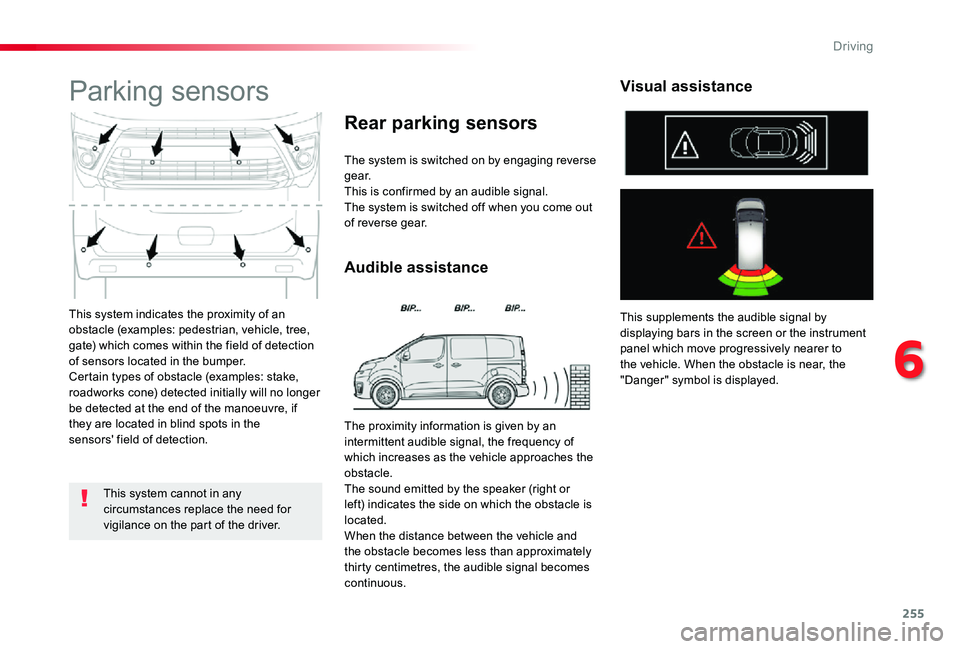
255
This system indicates the proximity of an obstacle (examples: pedestrian, vehicle, tree, gate) which comes within the field of detection of sensors located in the bumper.Certain types of obstacle (examples: stake, roadworks cone) detected initially will no longer be detected at the end of the manoeuvre, if they are located in blind spots in the sensors' field of detection.
Parking sensors
The system is switched on by engaging reverse g e a r.This is confirmed by an audible signal.The system is switched off when you come out of reverse gear.
Audible assistance
Rear parking sensors
This supplements the audible signal by displaying bars in the screen or the instrument panel which move progressively nearer to the vehicle. When the obstacle is near, the "Danger" symbol is displayed.
Visual assistance
This system cannot in any circumstances replace the need for vigilance on the part of the driver.
The proximity information is given by an intermittent audible signal, the frequency of which increases as the vehicle approaches the obstacle.The sound emitted by the speaker (right or left) indicates the side on which the obstacle is located.When the distance between the vehicle and the obstacle becomes less than approximately thirty centimetres, the audible signal becomes continuous.
6
Driving
Page 256 of 430
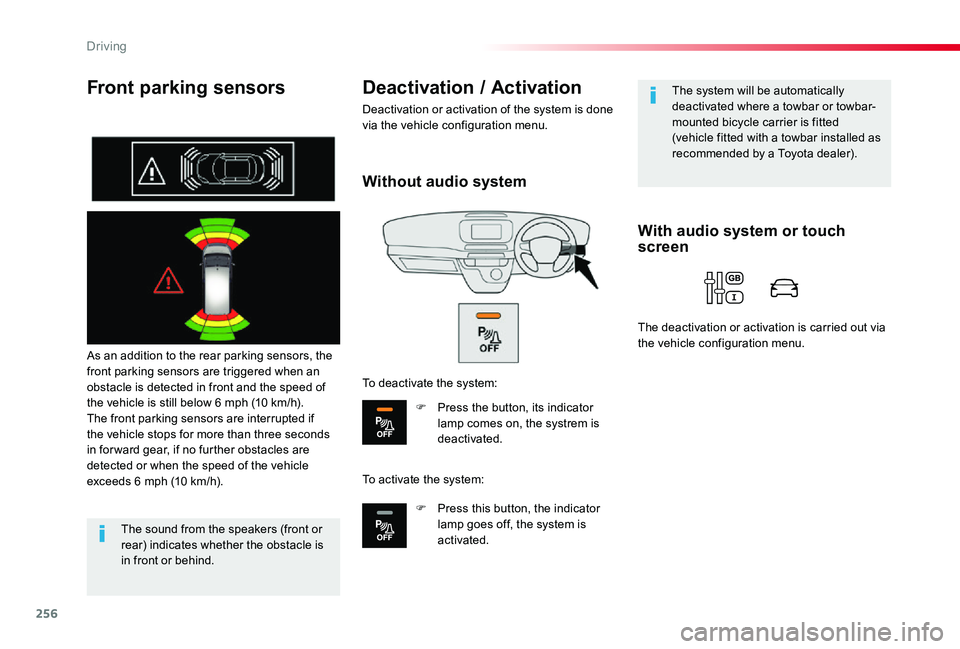
256
Front parking sensors
As an addition to the rear parking sensors, the front parking sensors are triggered when an obstacle is detected in front and the speed of the vehicle is still below 6 mph (10 km/h).The front parking sensors are interrupted if the vehicle stops for more than three seconds in for ward gear, if no further obstacles are detected or when the speed of the vehicle exceeds 6 mph (10 km/h).
Deactivation / Activation
Deactivation or activation of the system is done via the vehicle configuration menu.
The sound from the speakers (front or rear) indicates whether the obstacle is in front or behind.
The system will be automatically deactivated where a towbar or towbar-mounted bicycle carrier is fitted (vehicle fitted with a towbar installed as recommended by a Toyota dealer).
Without audio system
To deactivate the system:
F Press the button, its indicator lamp comes on, the systrem is deactivated.
To activate the system:
F Press this button, the indicator lamp goes off, the system is activated.
With audio system or touch screen
The deactivation or activation is carried out via the vehicle configuration menu.
Driving
Page 257 of 430
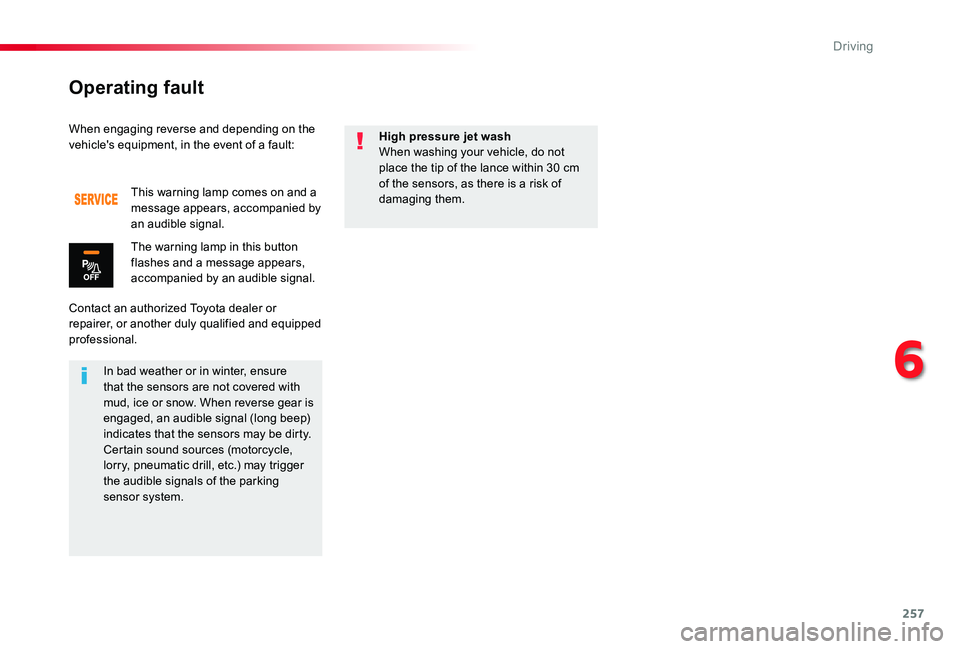
257
When engaging reverse and depending on the vehicle's equipment, in the event of a fault:
Contact an authorized Toyota dealer or repairer, or another duly qualified and equipped professional.
This warning lamp comes on and a message appears, accompanied by an audible signal.
The warning lamp in this button flashes and a message appears, accompanied by an audible signal.
In bad weather or in winter, ensure that the sensors are not covered with mud, ice or snow. When reverse gear is engaged, an audible signal (long beep) indicates that the sensors may be dirty.Certain sound sources (motorcycle, lorry, pneumatic drill, etc.) may trigger the audible signals of the parking sensor system.
High pressure jet washWhen washing your vehicle, do not place the tip of the lance within 30 cm of the sensors, as there is a risk of damaging them.
Operating fault
6
Driving
Page 258 of 430
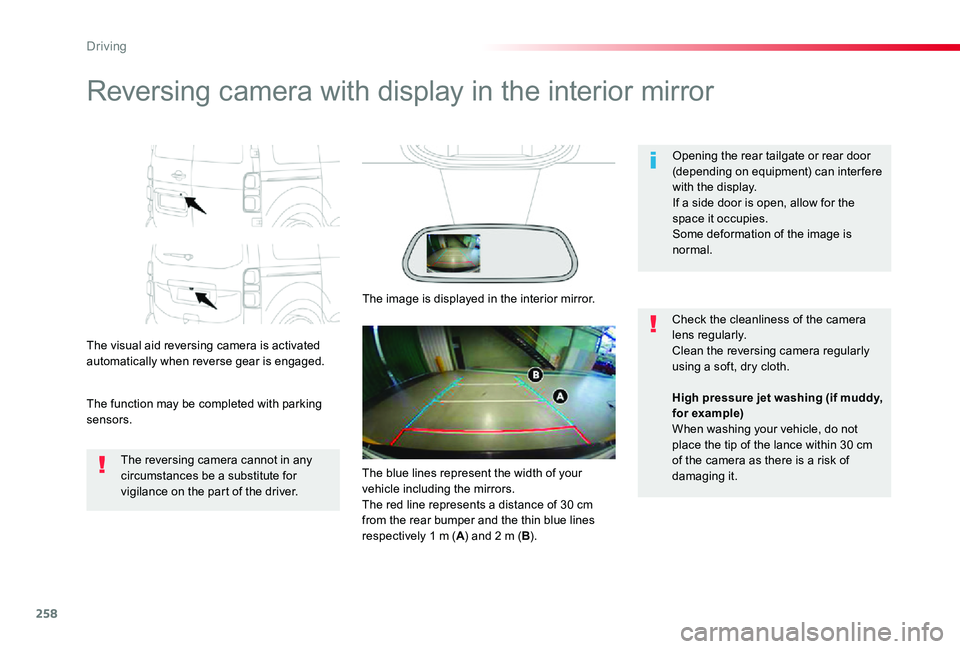
258
Reversing camera with display in the interior mirror
The visual aid reversing camera is activated automatically when reverse gear is engaged.
The function may be completed with parking sensors.
Opening the rear tailgate or rear door (depending on equipment) can interfere with the display.If a side door is open, allow for the space it occupies.Some deformation of the image is normal.
The reversing camera cannot in any circumstances be a substitute for vigilance on the part of the driver.
Check the cleanliness of the camera lens regularly.Clean the reversing camera regularly using a soft, dry cloth.
The image is displayed in the interior mirror.
High pressure jet washing (if muddy, for example)When washing your vehicle, do not
place the tip of the lance within 30 cm of the camera as there is a risk of damaging it.The blue lines represent the width of your vehicle including the mirrors.The red line represents a distance of 30 cm from the rear bumper and the thin blue lines respectively 1 m (A) and 2 m (B).
Driving
Page 259 of 430
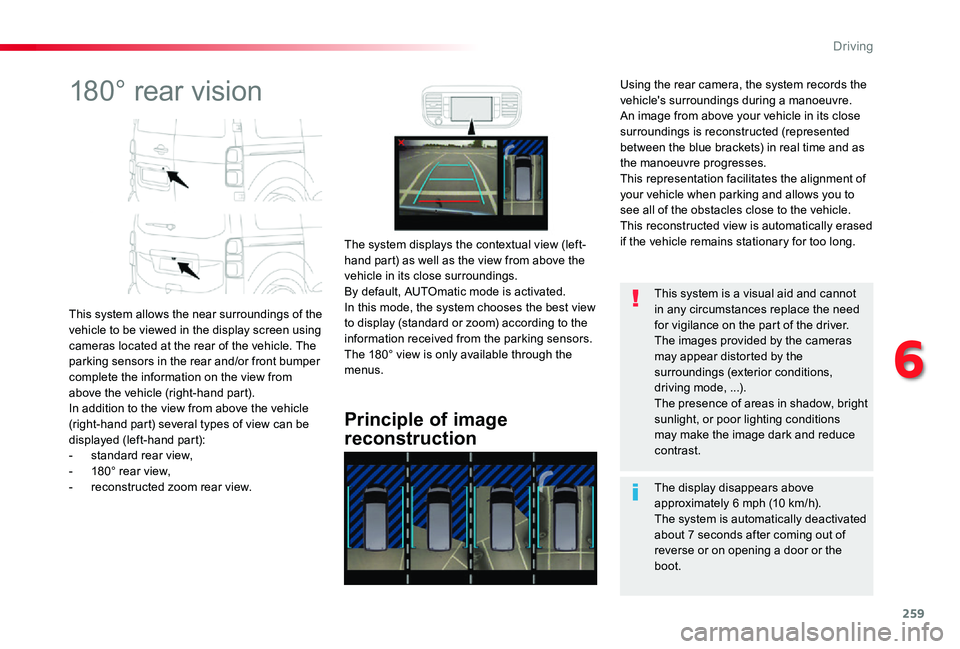
259
180° rear vision
This system allows the near surroundings of the vehicle to be viewed in the display screen using cameras located at the rear of the vehicle. The parking sensors in the rear and/or front bumper complete the information on the view from above the vehicle (right-hand part).In addition to the view from above the vehicle (right-hand part) several types of view can be displayed (left-hand part):- standard rear view,- 180° rear view,- reconstructed zoom rear view.
Principle of image
reconstruction
The system displays the contextual view (left-hand part) as well as the view from above the vehicle in its close surroundings.By default, AUTOmatic mode is activated.In this mode, the system chooses the best view to display (standard or zoom) according to the information received from the parking sensors.The 180° view is only available through the menus.
The display disappears above approximately 6 mph (10 km/h).The system is automatically deactivated about 7 seconds after coming out of
reverse or on opening a door or the boot.
This system is a visual aid and cannot in any circumstances replace the need for vigilance on the part of the driver.The images provided by the cameras may appear distorted by the surroundings (exterior conditions, driving mode, ...).The presence of areas in shadow, bright sunlight, or poor lighting conditions may make the image dark and reduce contrast.
Using the rear camera, the system records the vehicle's surroundings during a manoeuvre. An image from above your vehicle in its close surroundings is reconstructed (represented between the blue brackets) in real time and as the manoeuvre progresses.This representation facilitates the alignment of your vehicle when parking and allows you to see all of the obstacles close to the vehicle.This reconstructed view is automatically erased if the vehicle remains stationary for too long.
6
Driving
Page 260 of 430
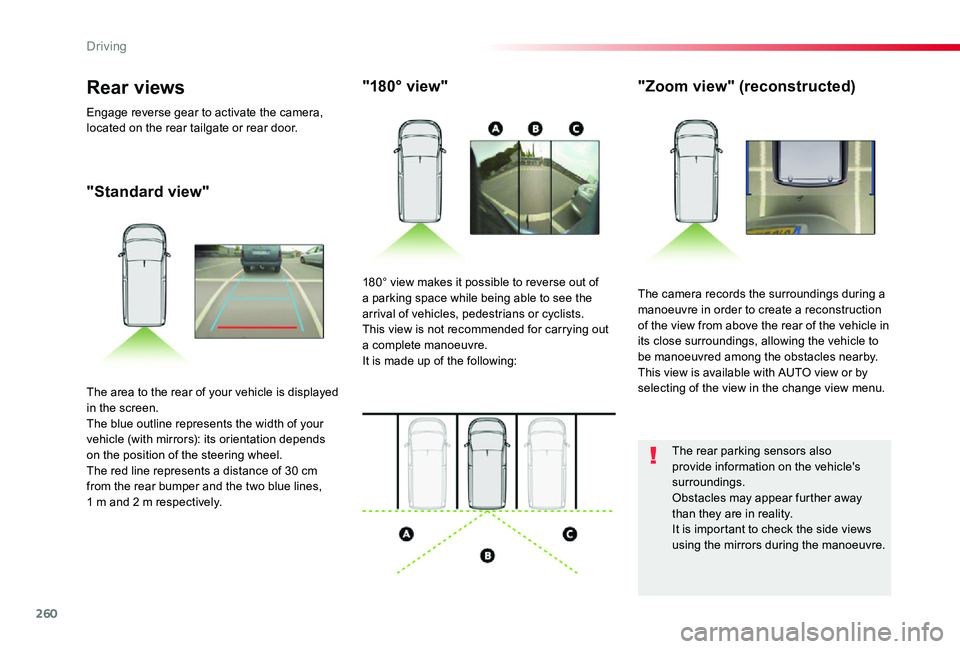
260
"Standard view"
"180° view""Zoom view" (reconstructed)
The camera records the surroundings during a manoeuvre in order to create a reconstruction of the view from above the rear of the vehicle in its close surroundings, allowing the vehicle to be manoeuvred among the obstacles nearby.This view is available with AUTO view or by selecting of the view in the change view menu.
180° view makes it possible to reverse out of a parking space while being able to see the arrival of vehicles, pedestrians or cyclists.This view is not recommended for carrying out a complete manoeuvre.It is made up of the following:
The area to the rear of your vehicle is displayed in the screen.The blue outline represents the width of your vehicle (with mirrors): its orientation depends on the position of the steering wheel.The red line represents a distance of 30 cm from the rear bumper and the two blue lines, 1 m and 2 m respectively.
Rear views
Engage reverse gear to activate the camera, located on the rear tailgate or rear door.
The rear parking sensors also provide information on the vehicle's surroundings.Obstacles may appear further away than they are in reality.It is important to check the side views
using the mirrors during the manoeuvre.
Driving